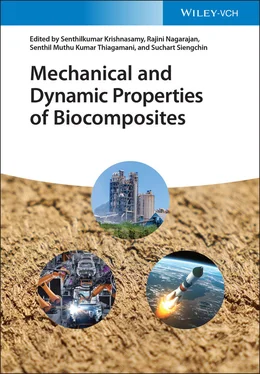Mechanical and Dynamic Properties of Biocomposites
Здесь есть возможность читать онлайн «Mechanical and Dynamic Properties of Biocomposites» — ознакомительный отрывок электронной книги совершенно бесплатно, а после прочтения отрывка купить полную версию. В некоторых случаях можно слушать аудио, скачать через торрент в формате fb2 и присутствует краткое содержание. Жанр: unrecognised, на английском языке. Описание произведения, (предисловие) а так же отзывы посетителей доступны на портале библиотеки ЛибКат.
- Название:Mechanical and Dynamic Properties of Biocomposites
- Автор:
- Жанр:
- Год:неизвестен
- ISBN:нет данных
- Рейтинг книги:4 / 5. Голосов: 1
-
Избранное:Добавить в избранное
- Отзывы:
-
Ваша оценка:
- 80
- 1
- 2
- 3
- 4
- 5
Mechanical and Dynamic Properties of Biocomposites: краткое содержание, описание и аннотация
Предлагаем к чтению аннотацию, описание, краткое содержание или предисловие (зависит от того, что написал сам автор книги «Mechanical and Dynamic Properties of Biocomposites»). Если вы не нашли необходимую информацию о книге — напишите в комментариях, мы постараемся отыскать её.
A comprehensive review of the properties of biocomposites and their applications Mechanical and Dynamic Properties of Biocomposites
Mechanical and Dynamic Properties of BIocomposites
Mechanical and Dynamic Properties of Biocomposites — читать онлайн ознакомительный отрывок
Ниже представлен текст книги, разбитый по страницам. Система сохранения места последней прочитанной страницы, позволяет с удобством читать онлайн бесплатно книгу «Mechanical and Dynamic Properties of Biocomposites», без необходимости каждый раз заново искать на чём Вы остановились. Поставьте закладку, и сможете в любой момент перейти на страницу, на которой закончили чтение.
Интервал:
Закладка:
Source: Nguyen et al. [4]. © 2017, Elsevier.
| Fiber | Density (g/cm 3) | Diameter (μm) | Elongation (%) | Tensile strength (MPa) | Young's modulus (GPa) |
|---|---|---|---|---|---|
| Bast | |||||
| Flax | 1.4–1.5 | 5–38 | 1.2–3.2 | 345–1500 | 27.6–80 |
| Hemp | 1.48 | 10–51 | 1.6 | 550–900 | 70 |
| Jute | 1.3–1.46 | 5–25 | 1.5–1.8 | 393–800 | 10–30 |
| Kenaf | 1.2 | 12–36 | 2.7–6.9 | 295 | — |
| Ramie | 1.5 | 18–80 | 2.0–3.8 | 220–938 | 44–128 |
| Leaf | |||||
| Abaca | 1.5 | — | 3.0–10 | 400 | 12 |
| Banana | 1.35 | 13.16 | 5.3 | 355 | 33.8 |
| Caraua | 1.4 | — | 3.7–4.3 | 500–1150 | 11.8 |
| Henequen | 1.4 | — | 3.0–4.7 | 430–580 | — |
| PALF | 1.5 | 20–80 | 1–3 | 170–1627 | 82 |
| Sisal | 1.33–1.5 | 7–47 | 2.0–3.0 | 400–700 | 9–38 |
| Seed | |||||
| Cotton | 1.5–1.6 | 12–35 | 3.0–10.0 | 287–597 | 5.5–12.6 |
| Fruit | |||||
| Coir | 1.2 | — | 15.0–30.0 | 175–220 | 4–6 |
| Oil palm EFB | 0.7–1.55 | 19.1–25.0 | 2.5 | 248 | 3.2 |
| Wood | |||||
| Softwood kraft pulp | 1.5 | 33 | 4.4 | 1000 | 40 |
| Cane/grass | |||||
| Bagasse | 1.2 | 10–34 | 1.1 | 20–290 | 19.7–27.1 |
| Bamboo | 0.6–1.1 | — | — | 140–230 | 11–17 |
EFB and PALF denote empty‐fruit bunches and pineapple leaf fiber, respectively.
Some interesting mechanical behaviors of commonly used natural fibers and many more that are not aforementioned are shown in Table 1.1.
Biocomposites have found application in many different industrial sectors, including packaging, sports articles, and ship building, but most importantly in civil and automotive sectors for nonstructural applications: soundproofing, filling material, and lightening, among others [3]. They favor applications that require low cost and lightness as compared with any other synthetic fiber‐reinforced composites. They also demonstrate good thermal and acoustic insulation capacities [3]. Generally, biocomposites are randomly oriented with short fibers that are obtained through the extrusion or molding manufacturing process [3]. Essentially, the low specific weight as well as low cost of biocomposites is a function of the low weight and low cost of most natural fibers, in combination with the low cost of the automated manufacturing processes when mass‐producing them [3].
1.2 Concept of Natural Fibers and/or Biopolymers: Biocomposites
1.2.1 Natural Fiber‐Reinforced Polymer Composites or Biocomposites
Natural fiber‐reinforced polymer (FRP) composites or biocomposites are gaining widespread interest for many reasons. One such reason is the fact that they have shown a potential for replacement of synthetic fibers at a lower cost. They are also sustainable when compared with their synthetic counterparts [5].
Natural fibers refer to fibers whose origins are natural, that is, they are sourced from plants and animals. These origins give rise to three fundamental natural fiber types, viz:
Animal fibers: These contain proteins, such as keratin, fibroin, and collagen. Other classifications in this category are animal wool/hairs (angora wool, alpaca, camel, mohair, lamb's wool, bison, yak wool, cashmere, horse hair, goat hair, and qiviut, among others), keratin fiber (chicken and bird feathers), and silk fibers (spider silk, tussah silkmoths, mulberry silk cocoons).
Plant fibers: These are often referred to as cellulosic or lignocellulosic fibers. They are classified in six categories:Seed/fruit fibers: Coir, coconut, loofah, cotton, oil palm, kapok, sponge gourd, milkweed hairs.Cane, grass, and reed fibers: Bamboo, corn, albardine, esparto, bagasse, sabai, papyrus, rape, canary.Bast or stem fibers: Blax, jute, okra, rattan, paper mulberry, hemp, kenaf, isora, urena, ramie, kudzu, roselle hemp, wisteria, mesta and nettle, among others.Wood fibers: Hardwood and softwood, among others.Leaf fibers: Caraua, pineapple, abaca, raphia, agave, caroa, banana, fique, piassava, cantala, sansevieria, phormium, Mauritius hemp, sisal, date palm, istle and henequen, to mention but a few.Stalk fibers: Derivable from barley stalk, rice stalk, maize stalk, wheat stalk, oat stalk as well as other crops. Table 1.2shows the percentage weight (wt.%) of chemical compositions of the mostly used natural fibers.
Mineral fibers: These fibers include fibrous brucite, asbestos group (amosite, chrysotile, anthophyllite, crocidolite, actinolite and tremolite) and wollastonite.
Table 1.2 Commonly used natural fibers in hybrid composites and their chemical compositions.
Source: Faruk et al. [6]. © 2012, Elsevier.
| Fiber | Cellulose (wt.%) | Hemicellulose (wt.%) | Lignin (wt.%) | Waxes (wt.%) |
|---|---|---|---|---|
| Abaca | 56–63 | 20–25 | 7–9 | 3 |
| Bagasse | 55.2 | 16.8 | 25.3 | — |
| Bamboo | 26–43 | 30 | 21–31 | — |
| Coir | 32–43 | 0.15–0.25 | 40–45 | — |
| Curaua | 73.6 | 9.9 | 7.5 | — |
| Flax | 71 | 18.6–20.6 | 2.2 | 1.5 |
| Hemp | 68 | 15 | 10 | 0.8 |
| Jute | 61–71 | 14–20 | 12–13 | 0.5 |
| Kenaf | 72 | 20.3 | 9 | — |
| Oil palm | 65 | — | 29 | — |
| Pineapple | 81 | — | 12.7 | — |
| Ramie | 68.6–76.2 | 13–16 | 0.6–0.7 | 0.3 |
| Rice husk | 35–45 | 19–25 | 20 | 14–17 |
| Rice straw | 41–57 | 33 | 8–19 | 8–38 |
| Sisal | 65 | 12 | 9.9 | 2 |
| Wheat straw | 38–45 | 15–31 | 12–20 | — |
1.2.2 Polymer Matrices
Polymer matrices serve as bonding agents to fibers. They bond the fibers together and help in load transfer to the fibers. Also, the polymer matrices allow for good‐quality finish of composite surfaces as well as protection of the reinforcing fibers from chemical attacks. Two common classifications of polymer matrices are thermosetting and thermoplastic resins. They are subsequently elucidated.
Thermosetting resins: Curing process (chemical reaction) occurs with this type, thus linking polymer chains and connecting the whole matrix in a three‐dimensional (3D) network. It should be noted that once curing occurs, re‐melting or reforming becomes impossible. These resins are highly stable in dimension, resist high temperature as well as offer good resistance to solvents, due to their cross‐linked 3D structure [4]. Some thermosetting resins that are used frequently in composites are vinylesters, polyesters, phenolics, epoxies, bismaleimides (BMIs), and polyamides (PAs).
Thermoplastic resins: These resins differ from thermosetting resins, because their thermoplastic molecules are not cross‐linked and can be melted when heated and made into solids and then cooled, thus allowing for reforming and reshaping repeatedly. Apart from being generally ductile, thermoplastic resins have more toughness than their thermosetting counterparts. They are broadly used for nonstructural applications without fillers and reinforcements. Their mechanical properties, which are factors of attraction, include good fatigue and compression strength, excellent tensile strength, excellent stiffness, high dimensional stability, excellent damage tolerance, and excellent durability. Furthermore, their flame‐retardant as well as wear‐resistant features broaden their applications and make them relevant, especially in an aerospace sector [4]. Common examples of thermoplastic resins include, but are not limited to, polyvinylidene fluoride (PVDF), polypropylene (PP), polyetheretherketone (PEEK), polyphenylene sulfide (PPS), polymethyl methacrylate (PMMA, also called acrylic), polyetherketoneketone (PEKK), and polyetherimide (PEI).
Читать дальшеИнтервал:
Закладка:
Похожие книги на «Mechanical and Dynamic Properties of Biocomposites»
Представляем Вашему вниманию похожие книги на «Mechanical and Dynamic Properties of Biocomposites» списком для выбора. Мы отобрали схожую по названию и смыслу литературу в надежде предоставить читателям больше вариантов отыскать новые, интересные, ещё непрочитанные произведения.
Обсуждение, отзывы о книге «Mechanical and Dynamic Properties of Biocomposites» и просто собственные мнения читателей. Оставьте ваши комментарии, напишите, что Вы думаете о произведении, его смысле или главных героях. Укажите что конкретно понравилось, а что нет, и почему Вы так считаете.












